Consumer Awareness and Sustainable Consumption in UK Car Industry
VerifiedAdded on 2023/01/19
|12
|3016
|22
Report
AI Summary
This report evaluates the impact of rising consumer consciousness towards sustainable consumption within the UK car industry. It begins with an introduction to the importance of sustainable development and then delves into the changing behaviors of consumers, driven by increased environmental awareness. The report explores two key consumer behavior models: the Engel Kollet Blackwell Model, which examines information input, processing, decision-making, and influencing variables; and the Family Decision Making Model, which analyzes the roles of different family members in purchasing decisions. It critically investigates research evidence, theories, and practices to evaluate change agents predicted to significantly influence the behaviors of customers. The report emphasizes the role of environmental factors and government regulations in shaping consumer demand and the automotive industry's response, including the growing importance of eco-friendly vehicles and the influence of consumer awareness on market trends. It also highlights the importance of change agents and the need for companies to adapt to environmental changes to remain competitive.
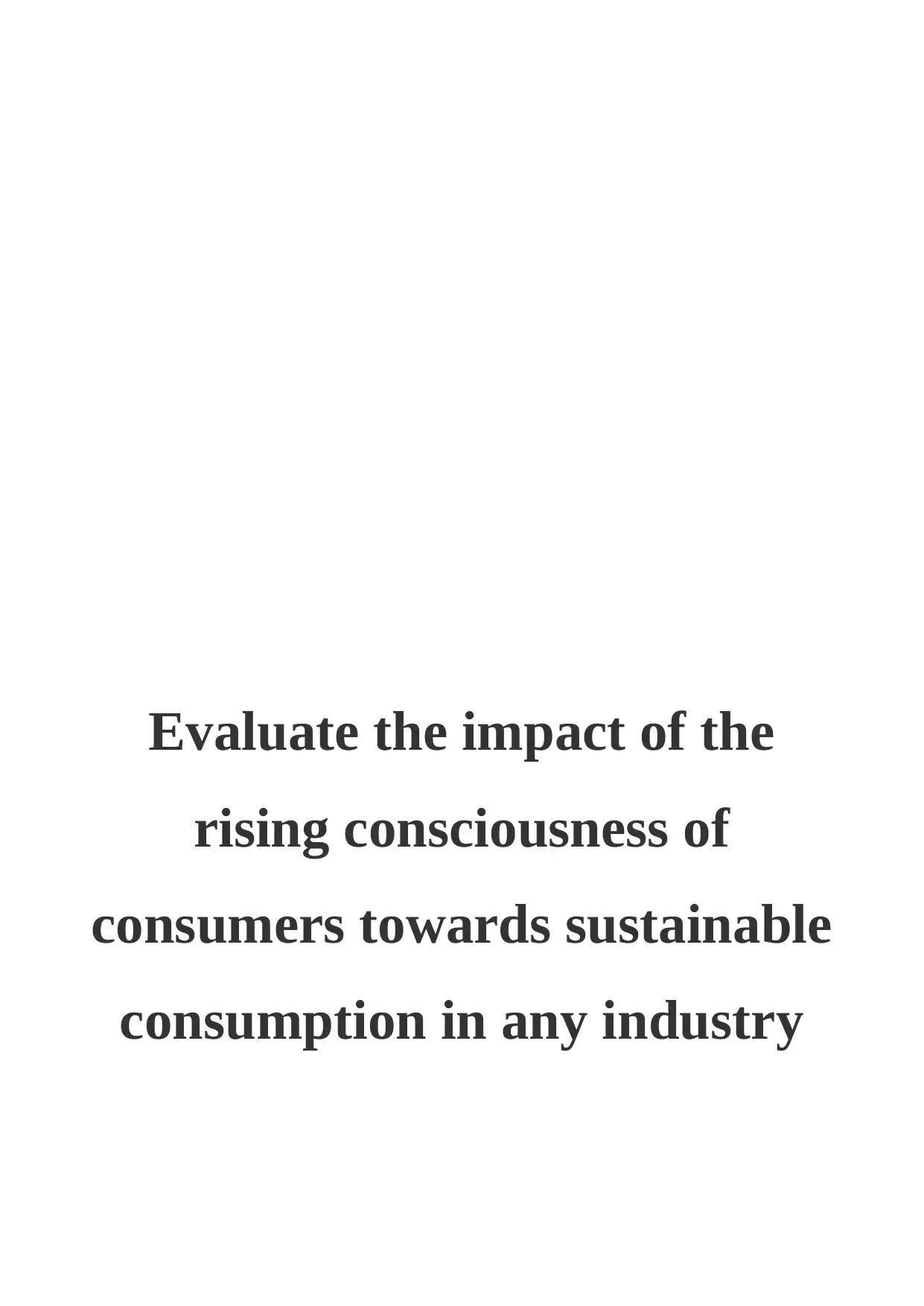
Evaluate the impact of the
rising consciousness of
consumers towards sustainable
consumption in any industry
rising consciousness of
consumers towards sustainable
consumption in any industry
Paraphrase This Document
Need a fresh take? Get an instant paraphrase of this document with our AI Paraphraser


⊘ This is a preview!⊘
Do you want full access?
Subscribe today to unlock all pages.

Trusted by 1+ million students worldwide
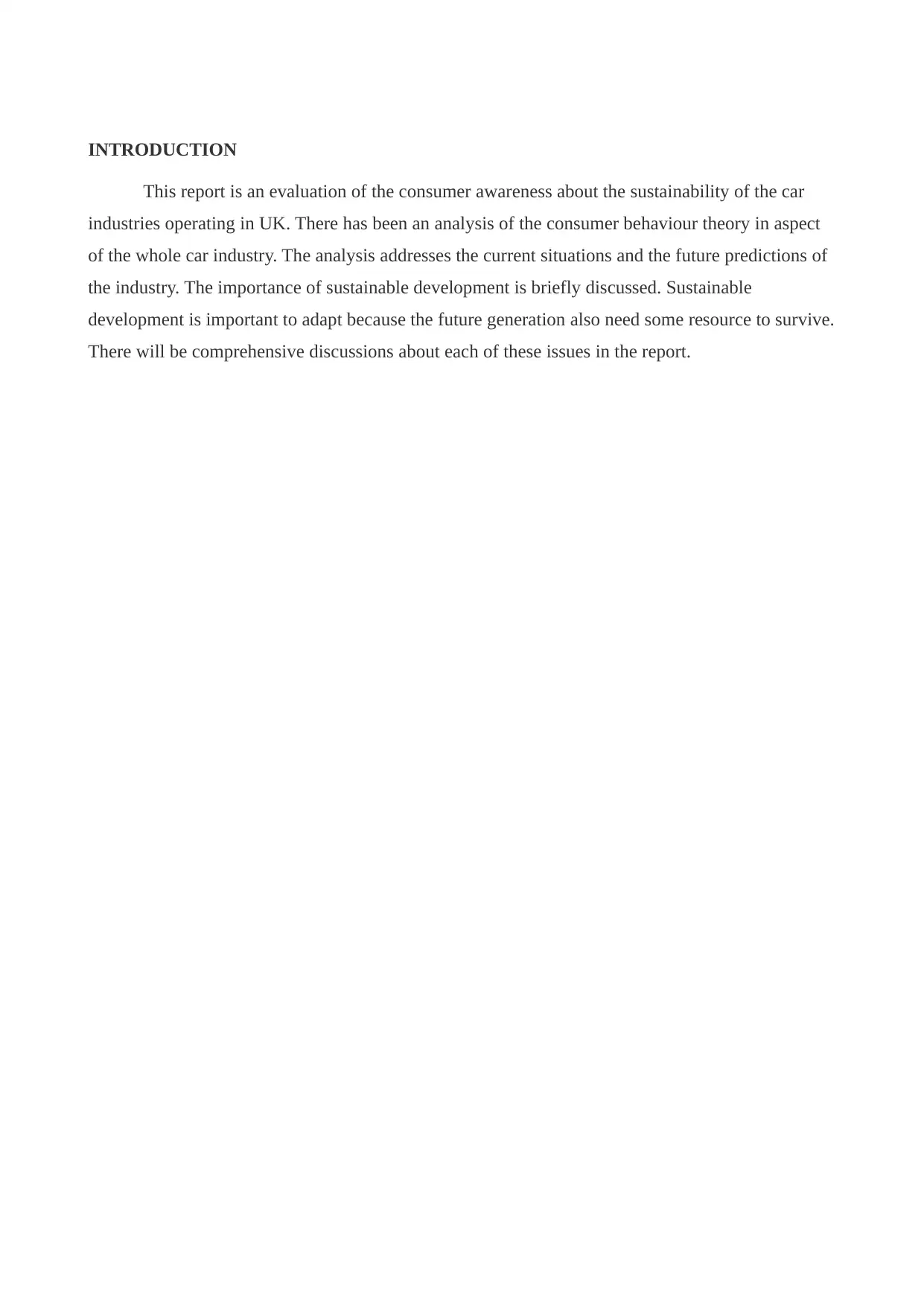
INTRODUCTION
This report is an evaluation of the consumer awareness about the sustainability of the car
industries operating in UK. There has been an analysis of the consumer behaviour theory in aspect
of the whole car industry. The analysis addresses the current situations and the future predictions of
the industry. The importance of sustainable development is briefly discussed. Sustainable
development is important to adapt because the future generation also need some resource to survive.
There will be comprehensive discussions about each of these issues in the report.
This report is an evaluation of the consumer awareness about the sustainability of the car
industries operating in UK. There has been an analysis of the consumer behaviour theory in aspect
of the whole car industry. The analysis addresses the current situations and the future predictions of
the industry. The importance of sustainable development is briefly discussed. Sustainable
development is important to adapt because the future generation also need some resource to survive.
There will be comprehensive discussions about each of these issues in the report.
Paraphrase This Document
Need a fresh take? Get an instant paraphrase of this document with our AI Paraphraser
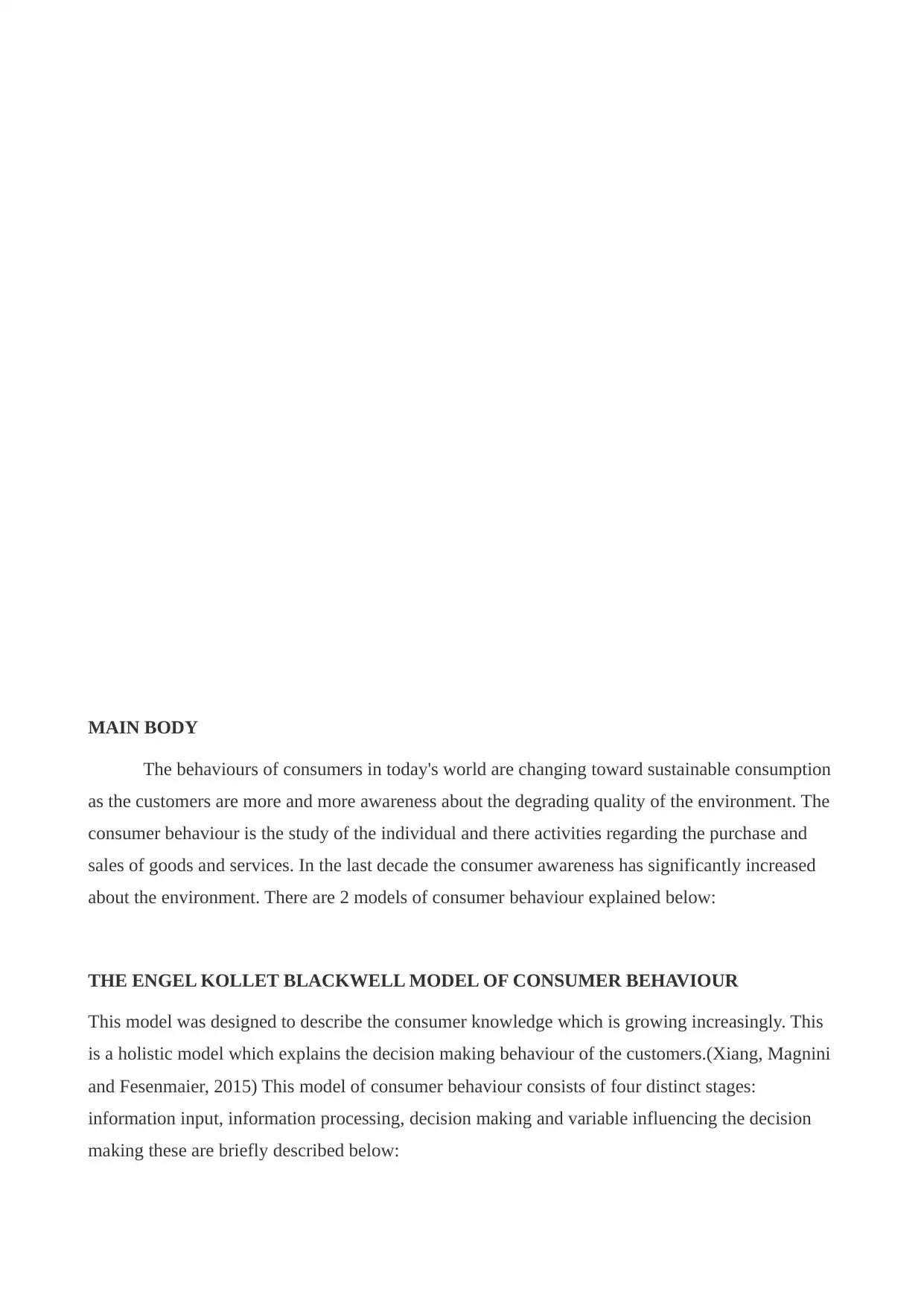
MAIN BODY
The behaviours of consumers in today's world are changing toward sustainable consumption
as the customers are more and more awareness about the degrading quality of the environment. The
consumer behaviour is the study of the individual and there activities regarding the purchase and
sales of goods and services. In the last decade the consumer awareness has significantly increased
about the environment. There are 2 models of consumer behaviour explained below:
THE ENGEL KOLLET BLACKWELL MODEL OF CONSUMER BEHAVIOUR
This model was designed to describe the consumer knowledge which is growing increasingly. This
is a holistic model which explains the decision making behaviour of the customers.(Xiang, Magnini
and Fesenmaier, 2015) This model of consumer behaviour consists of four distinct stages:
information input, information processing, decision making and variable influencing the decision
making these are briefly described below:
The behaviours of consumers in today's world are changing toward sustainable consumption
as the customers are more and more awareness about the degrading quality of the environment. The
consumer behaviour is the study of the individual and there activities regarding the purchase and
sales of goods and services. In the last decade the consumer awareness has significantly increased
about the environment. There are 2 models of consumer behaviour explained below:
THE ENGEL KOLLET BLACKWELL MODEL OF CONSUMER BEHAVIOUR
This model was designed to describe the consumer knowledge which is growing increasingly. This
is a holistic model which explains the decision making behaviour of the customers.(Xiang, Magnini
and Fesenmaier, 2015) This model of consumer behaviour consists of four distinct stages:
information input, information processing, decision making and variable influencing the decision
making these are briefly described below:
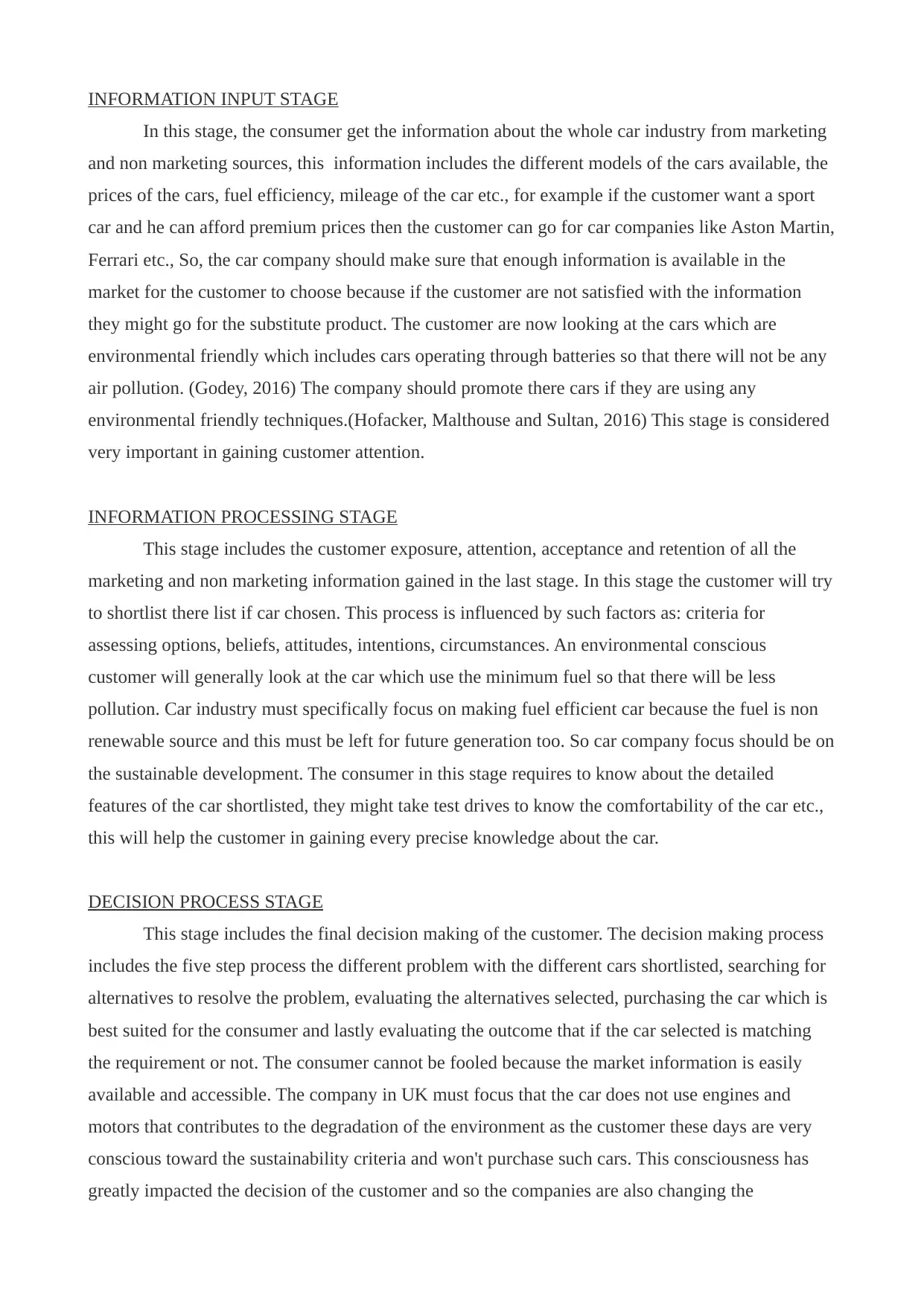
INFORMATION INPUT STAGE
In this stage, the consumer get the information about the whole car industry from marketing
and non marketing sources, this information includes the different models of the cars available, the
prices of the cars, fuel efficiency, mileage of the car etc., for example if the customer want a sport
car and he can afford premium prices then the customer can go for car companies like Aston Martin,
Ferrari etc., So, the car company should make sure that enough information is available in the
market for the customer to choose because if the customer are not satisfied with the information
they might go for the substitute product. The customer are now looking at the cars which are
environmental friendly which includes cars operating through batteries so that there will not be any
air pollution. (Godey, 2016) The company should promote there cars if they are using any
environmental friendly techniques.(Hofacker, Malthouse and Sultan, 2016) This stage is considered
very important in gaining customer attention.
INFORMATION PROCESSING STAGE
This stage includes the customer exposure, attention, acceptance and retention of all the
marketing and non marketing information gained in the last stage. In this stage the customer will try
to shortlist there list if car chosen. This process is influenced by such factors as: criteria for
assessing options, beliefs, attitudes, intentions, circumstances. An environmental conscious
customer will generally look at the car which use the minimum fuel so that there will be less
pollution. Car industry must specifically focus on making fuel efficient car because the fuel is non
renewable source and this must be left for future generation too. So car company focus should be on
the sustainable development. The consumer in this stage requires to know about the detailed
features of the car shortlisted, they might take test drives to know the comfortability of the car etc.,
this will help the customer in gaining every precise knowledge about the car.
DECISION PROCESS STAGE
This stage includes the final decision making of the customer. The decision making process
includes the five step process the different problem with the different cars shortlisted, searching for
alternatives to resolve the problem, evaluating the alternatives selected, purchasing the car which is
best suited for the consumer and lastly evaluating the outcome that if the car selected is matching
the requirement or not. The consumer cannot be fooled because the market information is easily
available and accessible. The company in UK must focus that the car does not use engines and
motors that contributes to the degradation of the environment as the customer these days are very
conscious toward the sustainability criteria and won't purchase such cars. This consciousness has
greatly impacted the decision of the customer and so the companies are also changing the
In this stage, the consumer get the information about the whole car industry from marketing
and non marketing sources, this information includes the different models of the cars available, the
prices of the cars, fuel efficiency, mileage of the car etc., for example if the customer want a sport
car and he can afford premium prices then the customer can go for car companies like Aston Martin,
Ferrari etc., So, the car company should make sure that enough information is available in the
market for the customer to choose because if the customer are not satisfied with the information
they might go for the substitute product. The customer are now looking at the cars which are
environmental friendly which includes cars operating through batteries so that there will not be any
air pollution. (Godey, 2016) The company should promote there cars if they are using any
environmental friendly techniques.(Hofacker, Malthouse and Sultan, 2016) This stage is considered
very important in gaining customer attention.
INFORMATION PROCESSING STAGE
This stage includes the customer exposure, attention, acceptance and retention of all the
marketing and non marketing information gained in the last stage. In this stage the customer will try
to shortlist there list if car chosen. This process is influenced by such factors as: criteria for
assessing options, beliefs, attitudes, intentions, circumstances. An environmental conscious
customer will generally look at the car which use the minimum fuel so that there will be less
pollution. Car industry must specifically focus on making fuel efficient car because the fuel is non
renewable source and this must be left for future generation too. So car company focus should be on
the sustainable development. The consumer in this stage requires to know about the detailed
features of the car shortlisted, they might take test drives to know the comfortability of the car etc.,
this will help the customer in gaining every precise knowledge about the car.
DECISION PROCESS STAGE
This stage includes the final decision making of the customer. The decision making process
includes the five step process the different problem with the different cars shortlisted, searching for
alternatives to resolve the problem, evaluating the alternatives selected, purchasing the car which is
best suited for the consumer and lastly evaluating the outcome that if the car selected is matching
the requirement or not. The consumer cannot be fooled because the market information is easily
available and accessible. The company in UK must focus that the car does not use engines and
motors that contributes to the degradation of the environment as the customer these days are very
conscious toward the sustainability criteria and won't purchase such cars. This consciousness has
greatly impacted the decision of the customer and so the companies are also changing the
⊘ This is a preview!⊘
Do you want full access?
Subscribe today to unlock all pages.

Trusted by 1+ million students worldwide
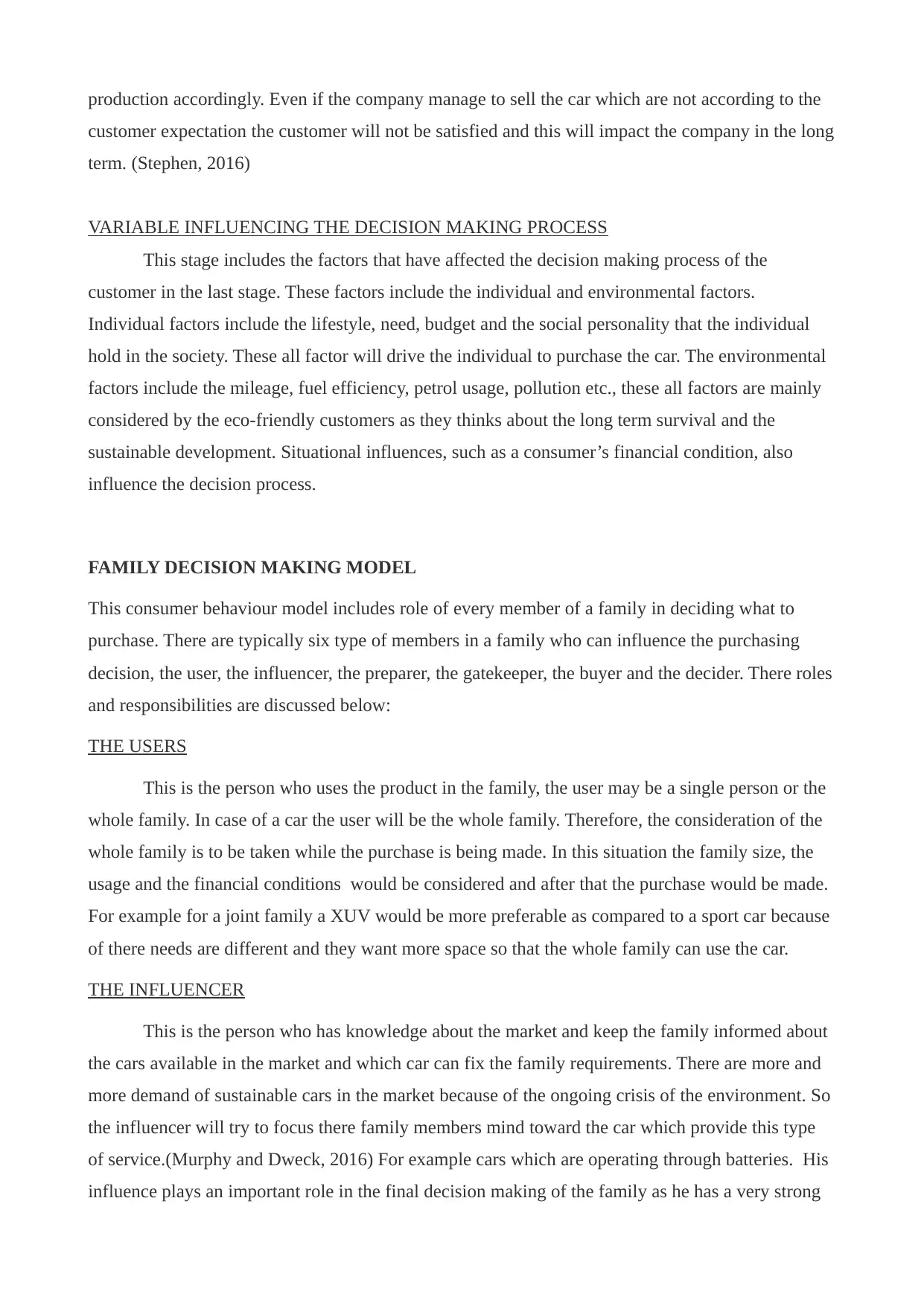
production accordingly. Even if the company manage to sell the car which are not according to the
customer expectation the customer will not be satisfied and this will impact the company in the long
term. (Stephen, 2016)
VARIABLE INFLUENCING THE DECISION MAKING PROCESS
This stage includes the factors that have affected the decision making process of the
customer in the last stage. These factors include the individual and environmental factors.
Individual factors include the lifestyle, need, budget and the social personality that the individual
hold in the society. These all factor will drive the individual to purchase the car. The environmental
factors include the mileage, fuel efficiency, petrol usage, pollution etc., these all factors are mainly
considered by the eco-friendly customers as they thinks about the long term survival and the
sustainable development. Situational influences, such as a consumer’s financial condition, also
influence the decision process.
FAMILY DECISION MAKING MODEL
This consumer behaviour model includes role of every member of a family in deciding what to
purchase. There are typically six type of members in a family who can influence the purchasing
decision, the user, the influencer, the preparer, the gatekeeper, the buyer and the decider. There roles
and responsibilities are discussed below:
THE USERS
This is the person who uses the product in the family, the user may be a single person or the
whole family. In case of a car the user will be the whole family. Therefore, the consideration of the
whole family is to be taken while the purchase is being made. In this situation the family size, the
usage and the financial conditions would be considered and after that the purchase would be made.
For example for a joint family a XUV would be more preferable as compared to a sport car because
of there needs are different and they want more space so that the whole family can use the car.
THE INFLUENCER
This is the person who has knowledge about the market and keep the family informed about
the cars available in the market and which car can fix the family requirements. There are more and
more demand of sustainable cars in the market because of the ongoing crisis of the environment. So
the influencer will try to focus there family members mind toward the car which provide this type
of service.(Murphy and Dweck, 2016) For example cars which are operating through batteries. His
influence plays an important role in the final decision making of the family as he has a very strong
customer expectation the customer will not be satisfied and this will impact the company in the long
term. (Stephen, 2016)
VARIABLE INFLUENCING THE DECISION MAKING PROCESS
This stage includes the factors that have affected the decision making process of the
customer in the last stage. These factors include the individual and environmental factors.
Individual factors include the lifestyle, need, budget and the social personality that the individual
hold in the society. These all factor will drive the individual to purchase the car. The environmental
factors include the mileage, fuel efficiency, petrol usage, pollution etc., these all factors are mainly
considered by the eco-friendly customers as they thinks about the long term survival and the
sustainable development. Situational influences, such as a consumer’s financial condition, also
influence the decision process.
FAMILY DECISION MAKING MODEL
This consumer behaviour model includes role of every member of a family in deciding what to
purchase. There are typically six type of members in a family who can influence the purchasing
decision, the user, the influencer, the preparer, the gatekeeper, the buyer and the decider. There roles
and responsibilities are discussed below:
THE USERS
This is the person who uses the product in the family, the user may be a single person or the
whole family. In case of a car the user will be the whole family. Therefore, the consideration of the
whole family is to be taken while the purchase is being made. In this situation the family size, the
usage and the financial conditions would be considered and after that the purchase would be made.
For example for a joint family a XUV would be more preferable as compared to a sport car because
of there needs are different and they want more space so that the whole family can use the car.
THE INFLUENCER
This is the person who has knowledge about the market and keep the family informed about
the cars available in the market and which car can fix the family requirements. There are more and
more demand of sustainable cars in the market because of the ongoing crisis of the environment. So
the influencer will try to focus there family members mind toward the car which provide this type
of service.(Murphy and Dweck, 2016) For example cars which are operating through batteries. His
influence plays an important role in the final decision making of the family as he has a very strong
Paraphrase This Document
Need a fresh take? Get an instant paraphrase of this document with our AI Paraphraser
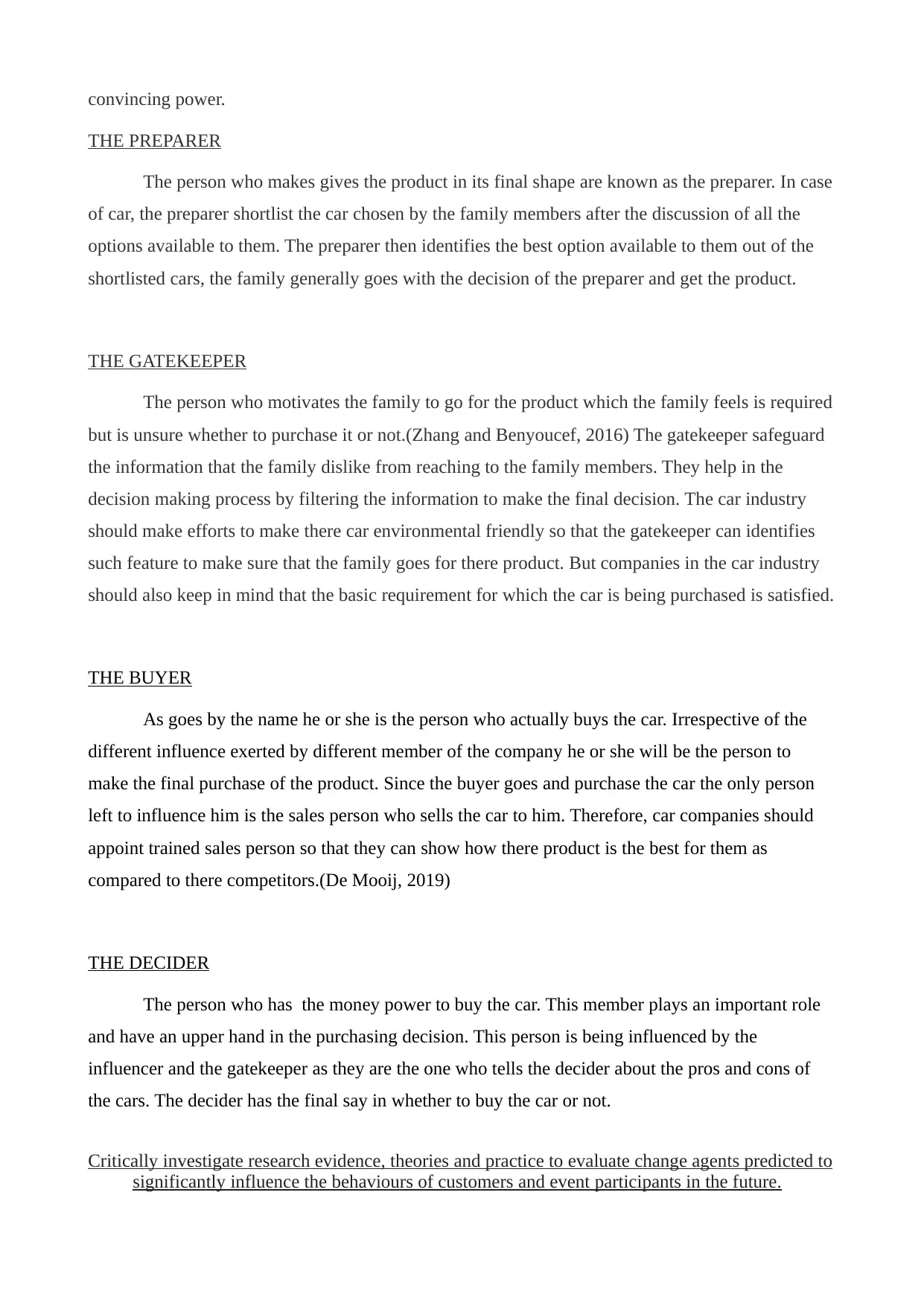
convincing power.
THE PREPARER
The person who makes gives the product in its final shape are known as the preparer. In case
of car, the preparer shortlist the car chosen by the family members after the discussion of all the
options available to them. The preparer then identifies the best option available to them out of the
shortlisted cars, the family generally goes with the decision of the preparer and get the product.
THE GATEKEEPER
The person who motivates the family to go for the product which the family feels is required
but is unsure whether to purchase it or not.(Zhang and Benyoucef, 2016) The gatekeeper safeguard
the information that the family dislike from reaching to the family members. They help in the
decision making process by filtering the information to make the final decision. The car industry
should make efforts to make there car environmental friendly so that the gatekeeper can identifies
such feature to make sure that the family goes for there product. But companies in the car industry
should also keep in mind that the basic requirement for which the car is being purchased is satisfied.
THE BUYER
As goes by the name he or she is the person who actually buys the car. Irrespective of the
different influence exerted by different member of the company he or she will be the person to
make the final purchase of the product. Since the buyer goes and purchase the car the only person
left to influence him is the sales person who sells the car to him. Therefore, car companies should
appoint trained sales person so that they can show how there product is the best for them as
compared to there competitors.(De Mooij, 2019)
THE DECIDER
The person who has the money power to buy the car. This member plays an important role
and have an upper hand in the purchasing decision. This person is being influenced by the
influencer and the gatekeeper as they are the one who tells the decider about the pros and cons of
the cars. The decider has the final say in whether to buy the car or not.
Critically investigate research evidence, theories and practice to evaluate change agents predicted to
significantly influence the behaviours of customers and event participants in the future.
THE PREPARER
The person who makes gives the product in its final shape are known as the preparer. In case
of car, the preparer shortlist the car chosen by the family members after the discussion of all the
options available to them. The preparer then identifies the best option available to them out of the
shortlisted cars, the family generally goes with the decision of the preparer and get the product.
THE GATEKEEPER
The person who motivates the family to go for the product which the family feels is required
but is unsure whether to purchase it or not.(Zhang and Benyoucef, 2016) The gatekeeper safeguard
the information that the family dislike from reaching to the family members. They help in the
decision making process by filtering the information to make the final decision. The car industry
should make efforts to make there car environmental friendly so that the gatekeeper can identifies
such feature to make sure that the family goes for there product. But companies in the car industry
should also keep in mind that the basic requirement for which the car is being purchased is satisfied.
THE BUYER
As goes by the name he or she is the person who actually buys the car. Irrespective of the
different influence exerted by different member of the company he or she will be the person to
make the final purchase of the product. Since the buyer goes and purchase the car the only person
left to influence him is the sales person who sells the car to him. Therefore, car companies should
appoint trained sales person so that they can show how there product is the best for them as
compared to there competitors.(De Mooij, 2019)
THE DECIDER
The person who has the money power to buy the car. This member plays an important role
and have an upper hand in the purchasing decision. This person is being influenced by the
influencer and the gatekeeper as they are the one who tells the decider about the pros and cons of
the cars. The decider has the final say in whether to buy the car or not.
Critically investigate research evidence, theories and practice to evaluate change agents predicted to
significantly influence the behaviours of customers and event participants in the future.
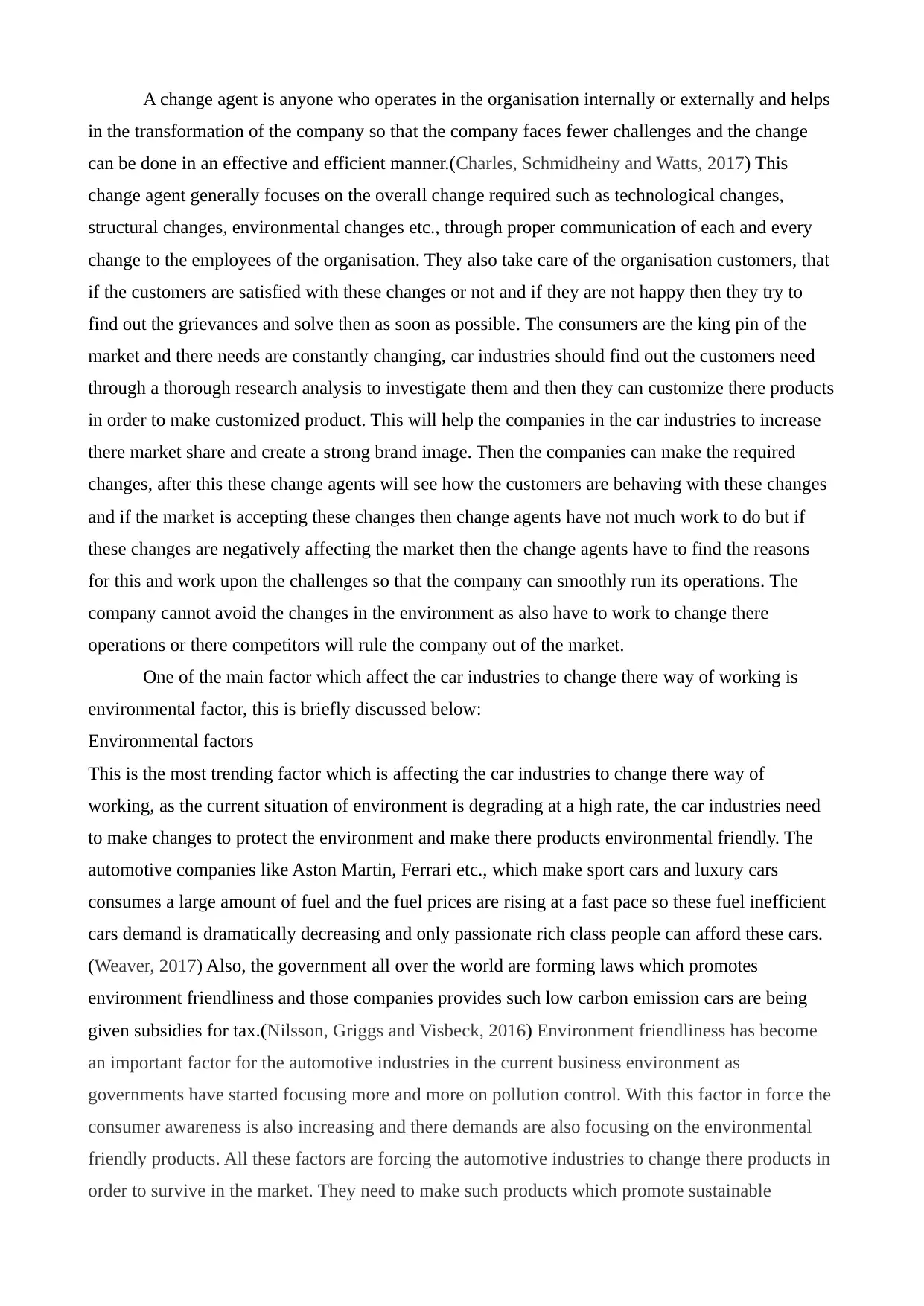
A change agent is anyone who operates in the organisation internally or externally and helps
in the transformation of the company so that the company faces fewer challenges and the change
can be done in an effective and efficient manner.(Charles, Schmidheiny and Watts, 2017) This
change agent generally focuses on the overall change required such as technological changes,
structural changes, environmental changes etc., through proper communication of each and every
change to the employees of the organisation. They also take care of the organisation customers, that
if the customers are satisfied with these changes or not and if they are not happy then they try to
find out the grievances and solve then as soon as possible. The consumers are the king pin of the
market and there needs are constantly changing, car industries should find out the customers need
through a thorough research analysis to investigate them and then they can customize there products
in order to make customized product. This will help the companies in the car industries to increase
there market share and create a strong brand image. Then the companies can make the required
changes, after this these change agents will see how the customers are behaving with these changes
and if the market is accepting these changes then change agents have not much work to do but if
these changes are negatively affecting the market then the change agents have to find the reasons
for this and work upon the challenges so that the company can smoothly run its operations. The
company cannot avoid the changes in the environment as also have to work to change there
operations or there competitors will rule the company out of the market.
One of the main factor which affect the car industries to change there way of working is
environmental factor, this is briefly discussed below:
Environmental factors
This is the most trending factor which is affecting the car industries to change there way of
working, as the current situation of environment is degrading at a high rate, the car industries need
to make changes to protect the environment and make there products environmental friendly. The
automotive companies like Aston Martin, Ferrari etc., which make sport cars and luxury cars
consumes a large amount of fuel and the fuel prices are rising at a fast pace so these fuel inefficient
cars demand is dramatically decreasing and only passionate rich class people can afford these cars.
(Weaver, 2017) Also, the government all over the world are forming laws which promotes
environment friendliness and those companies provides such low carbon emission cars are being
given subsidies for tax.(Nilsson, Griggs and Visbeck, 2016) Environment friendliness has become
an important factor for the automotive industries in the current business environment as
governments have started focusing more and more on pollution control. With this factor in force the
consumer awareness is also increasing and there demands are also focusing on the environmental
friendly products. All these factors are forcing the automotive industries to change there products in
order to survive in the market. They need to make such products which promote sustainable
in the transformation of the company so that the company faces fewer challenges and the change
can be done in an effective and efficient manner.(Charles, Schmidheiny and Watts, 2017) This
change agent generally focuses on the overall change required such as technological changes,
structural changes, environmental changes etc., through proper communication of each and every
change to the employees of the organisation. They also take care of the organisation customers, that
if the customers are satisfied with these changes or not and if they are not happy then they try to
find out the grievances and solve then as soon as possible. The consumers are the king pin of the
market and there needs are constantly changing, car industries should find out the customers need
through a thorough research analysis to investigate them and then they can customize there products
in order to make customized product. This will help the companies in the car industries to increase
there market share and create a strong brand image. Then the companies can make the required
changes, after this these change agents will see how the customers are behaving with these changes
and if the market is accepting these changes then change agents have not much work to do but if
these changes are negatively affecting the market then the change agents have to find the reasons
for this and work upon the challenges so that the company can smoothly run its operations. The
company cannot avoid the changes in the environment as also have to work to change there
operations or there competitors will rule the company out of the market.
One of the main factor which affect the car industries to change there way of working is
environmental factor, this is briefly discussed below:
Environmental factors
This is the most trending factor which is affecting the car industries to change there way of
working, as the current situation of environment is degrading at a high rate, the car industries need
to make changes to protect the environment and make there products environmental friendly. The
automotive companies like Aston Martin, Ferrari etc., which make sport cars and luxury cars
consumes a large amount of fuel and the fuel prices are rising at a fast pace so these fuel inefficient
cars demand is dramatically decreasing and only passionate rich class people can afford these cars.
(Weaver, 2017) Also, the government all over the world are forming laws which promotes
environment friendliness and those companies provides such low carbon emission cars are being
given subsidies for tax.(Nilsson, Griggs and Visbeck, 2016) Environment friendliness has become
an important factor for the automotive industries in the current business environment as
governments have started focusing more and more on pollution control. With this factor in force the
consumer awareness is also increasing and there demands are also focusing on the environmental
friendly products. All these factors are forcing the automotive industries to change there products in
order to survive in the market. They need to make such products which promote sustainable
⊘ This is a preview!⊘
Do you want full access?
Subscribe today to unlock all pages.

Trusted by 1+ million students worldwide
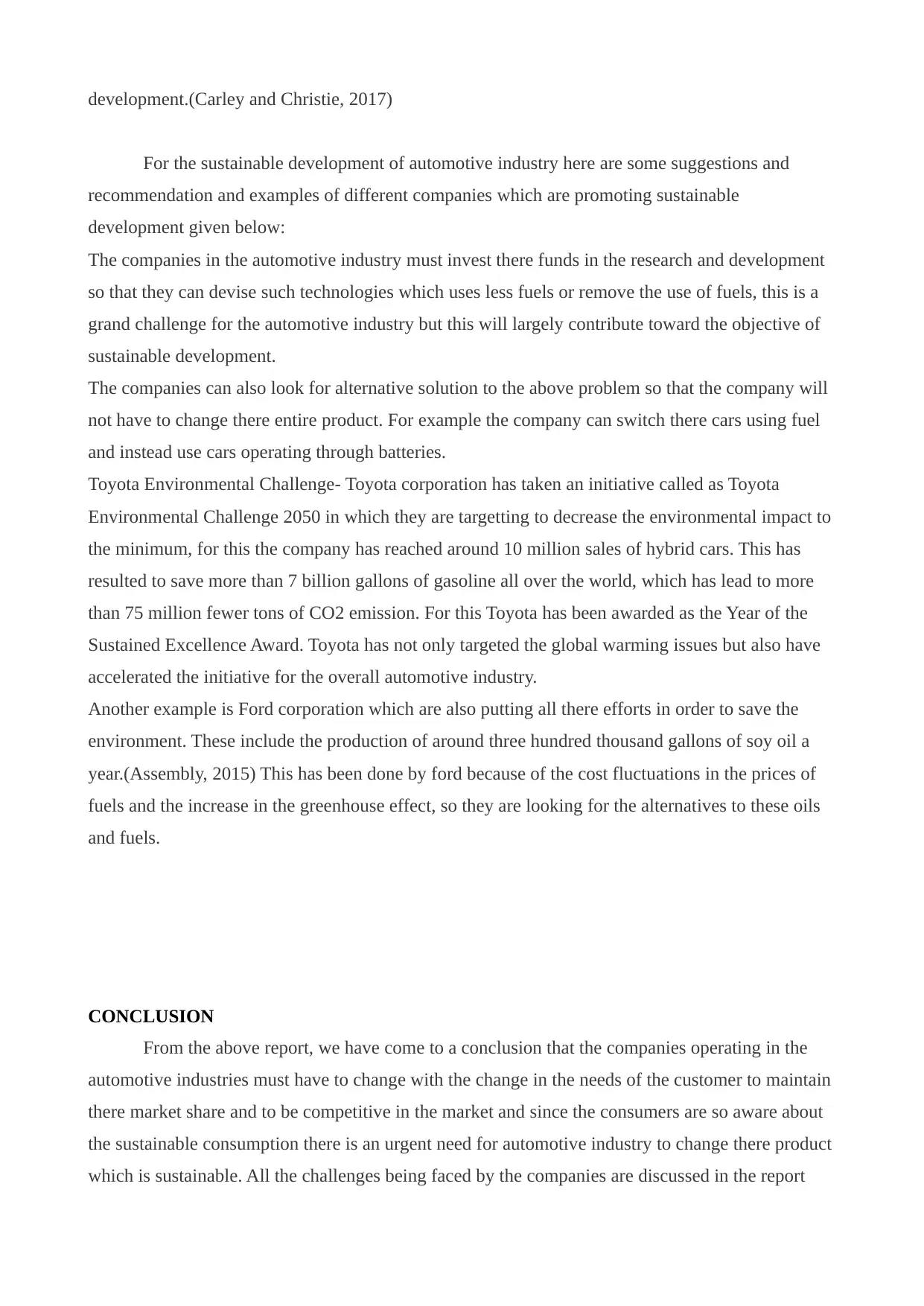
development.(Carley and Christie, 2017)
For the sustainable development of automotive industry here are some suggestions and
recommendation and examples of different companies which are promoting sustainable
development given below:
The companies in the automotive industry must invest there funds in the research and development
so that they can devise such technologies which uses less fuels or remove the use of fuels, this is a
grand challenge for the automotive industry but this will largely contribute toward the objective of
sustainable development.
The companies can also look for alternative solution to the above problem so that the company will
not have to change there entire product. For example the company can switch there cars using fuel
and instead use cars operating through batteries.
Toyota Environmental Challenge- Toyota corporation has taken an initiative called as Toyota
Environmental Challenge 2050 in which they are targetting to decrease the environmental impact to
the minimum, for this the company has reached around 10 million sales of hybrid cars. This has
resulted to save more than 7 billion gallons of gasoline all over the world, which has lead to more
than 75 million fewer tons of CO2 emission. For this Toyota has been awarded as the Year of the
Sustained Excellence Award. Toyota has not only targeted the global warming issues but also have
accelerated the initiative for the overall automotive industry.
Another example is Ford corporation which are also putting all there efforts in order to save the
environment. These include the production of around three hundred thousand gallons of soy oil a
year.(Assembly, 2015) This has been done by ford because of the cost fluctuations in the prices of
fuels and the increase in the greenhouse effect, so they are looking for the alternatives to these oils
and fuels.
CONCLUSION
From the above report, we have come to a conclusion that the companies operating in the
automotive industries must have to change with the change in the needs of the customer to maintain
there market share and to be competitive in the market and since the consumers are so aware about
the sustainable consumption there is an urgent need for automotive industry to change there product
which is sustainable. All the challenges being faced by the companies are discussed in the report
For the sustainable development of automotive industry here are some suggestions and
recommendation and examples of different companies which are promoting sustainable
development given below:
The companies in the automotive industry must invest there funds in the research and development
so that they can devise such technologies which uses less fuels or remove the use of fuels, this is a
grand challenge for the automotive industry but this will largely contribute toward the objective of
sustainable development.
The companies can also look for alternative solution to the above problem so that the company will
not have to change there entire product. For example the company can switch there cars using fuel
and instead use cars operating through batteries.
Toyota Environmental Challenge- Toyota corporation has taken an initiative called as Toyota
Environmental Challenge 2050 in which they are targetting to decrease the environmental impact to
the minimum, for this the company has reached around 10 million sales of hybrid cars. This has
resulted to save more than 7 billion gallons of gasoline all over the world, which has lead to more
than 75 million fewer tons of CO2 emission. For this Toyota has been awarded as the Year of the
Sustained Excellence Award. Toyota has not only targeted the global warming issues but also have
accelerated the initiative for the overall automotive industry.
Another example is Ford corporation which are also putting all there efforts in order to save the
environment. These include the production of around three hundred thousand gallons of soy oil a
year.(Assembly, 2015) This has been done by ford because of the cost fluctuations in the prices of
fuels and the increase in the greenhouse effect, so they are looking for the alternatives to these oils
and fuels.
CONCLUSION
From the above report, we have come to a conclusion that the companies operating in the
automotive industries must have to change with the change in the needs of the customer to maintain
there market share and to be competitive in the market and since the consumers are so aware about
the sustainable consumption there is an urgent need for automotive industry to change there product
which is sustainable. All the challenges being faced by the companies are discussed in the report
Paraphrase This Document
Need a fresh take? Get an instant paraphrase of this document with our AI Paraphraser
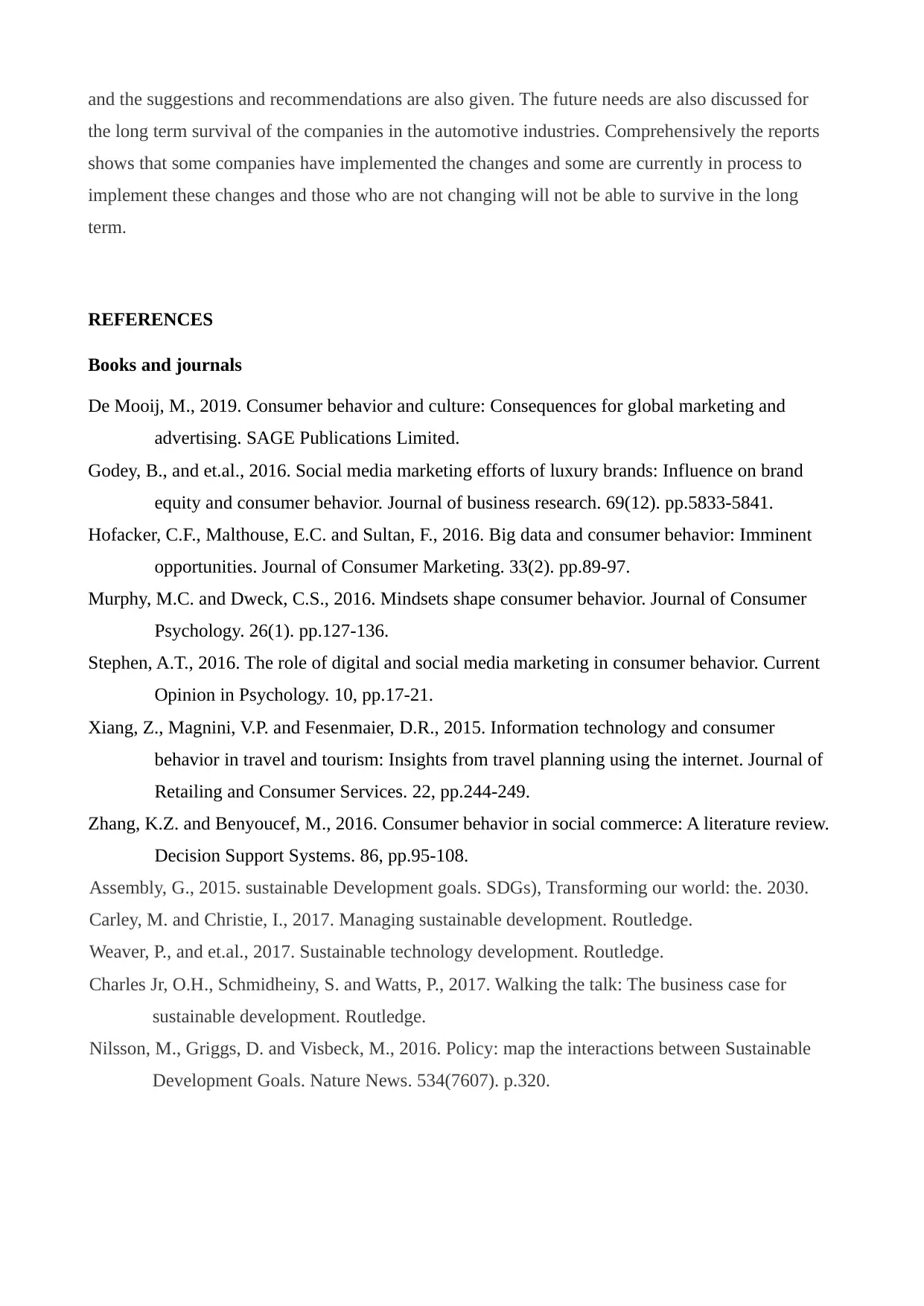
and the suggestions and recommendations are also given. The future needs are also discussed for
the long term survival of the companies in the automotive industries. Comprehensively the reports
shows that some companies have implemented the changes and some are currently in process to
implement these changes and those who are not changing will not be able to survive in the long
term.
REFERENCES
Books and journals
De Mooij, M., 2019. Consumer behavior and culture: Consequences for global marketing and
advertising. SAGE Publications Limited.
Godey, B., and et.al., 2016. Social media marketing efforts of luxury brands: Influence on brand
equity and consumer behavior. Journal of business research. 69(12). pp.5833-5841.
Hofacker, C.F., Malthouse, E.C. and Sultan, F., 2016. Big data and consumer behavior: Imminent
opportunities. Journal of Consumer Marketing. 33(2). pp.89-97.
Murphy, M.C. and Dweck, C.S., 2016. Mindsets shape consumer behavior. Journal of Consumer
Psychology. 26(1). pp.127-136.
Stephen, A.T., 2016. The role of digital and social media marketing in consumer behavior. Current
Opinion in Psychology. 10, pp.17-21.
Xiang, Z., Magnini, V.P. and Fesenmaier, D.R., 2015. Information technology and consumer
behavior in travel and tourism: Insights from travel planning using the internet. Journal of
Retailing and Consumer Services. 22, pp.244-249.
Zhang, K.Z. and Benyoucef, M., 2016. Consumer behavior in social commerce: A literature review.
Decision Support Systems. 86, pp.95-108.
Assembly, G., 2015. sustainable Development goals. SDGs), Transforming our world: the. 2030.
Carley, M. and Christie, I., 2017. Managing sustainable development. Routledge.
Weaver, P., and et.al., 2017. Sustainable technology development. Routledge.
Charles Jr, O.H., Schmidheiny, S. and Watts, P., 2017. Walking the talk: The business case for
sustainable development. Routledge.
Nilsson, M., Griggs, D. and Visbeck, M., 2016. Policy: map the interactions between Sustainable
Development Goals. Nature News. 534(7607). p.320.
the long term survival of the companies in the automotive industries. Comprehensively the reports
shows that some companies have implemented the changes and some are currently in process to
implement these changes and those who are not changing will not be able to survive in the long
term.
REFERENCES
Books and journals
De Mooij, M., 2019. Consumer behavior and culture: Consequences for global marketing and
advertising. SAGE Publications Limited.
Godey, B., and et.al., 2016. Social media marketing efforts of luxury brands: Influence on brand
equity and consumer behavior. Journal of business research. 69(12). pp.5833-5841.
Hofacker, C.F., Malthouse, E.C. and Sultan, F., 2016. Big data and consumer behavior: Imminent
opportunities. Journal of Consumer Marketing. 33(2). pp.89-97.
Murphy, M.C. and Dweck, C.S., 2016. Mindsets shape consumer behavior. Journal of Consumer
Psychology. 26(1). pp.127-136.
Stephen, A.T., 2016. The role of digital and social media marketing in consumer behavior. Current
Opinion in Psychology. 10, pp.17-21.
Xiang, Z., Magnini, V.P. and Fesenmaier, D.R., 2015. Information technology and consumer
behavior in travel and tourism: Insights from travel planning using the internet. Journal of
Retailing and Consumer Services. 22, pp.244-249.
Zhang, K.Z. and Benyoucef, M., 2016. Consumer behavior in social commerce: A literature review.
Decision Support Systems. 86, pp.95-108.
Assembly, G., 2015. sustainable Development goals. SDGs), Transforming our world: the. 2030.
Carley, M. and Christie, I., 2017. Managing sustainable development. Routledge.
Weaver, P., and et.al., 2017. Sustainable technology development. Routledge.
Charles Jr, O.H., Schmidheiny, S. and Watts, P., 2017. Walking the talk: The business case for
sustainable development. Routledge.
Nilsson, M., Griggs, D. and Visbeck, M., 2016. Policy: map the interactions between Sustainable
Development Goals. Nature News. 534(7607). p.320.

⊘ This is a preview!⊘
Do you want full access?
Subscribe today to unlock all pages.

Trusted by 1+ million students worldwide
1 out of 12
Related Documents
Your All-in-One AI-Powered Toolkit for Academic Success.
+13062052269
info@desklib.com
Available 24*7 on WhatsApp / Email
![[object Object]](/_next/static/media/star-bottom.7253800d.svg)
Unlock your academic potential
Copyright © 2020–2025 A2Z Services. All Rights Reserved. Developed and managed by ZUCOL.




